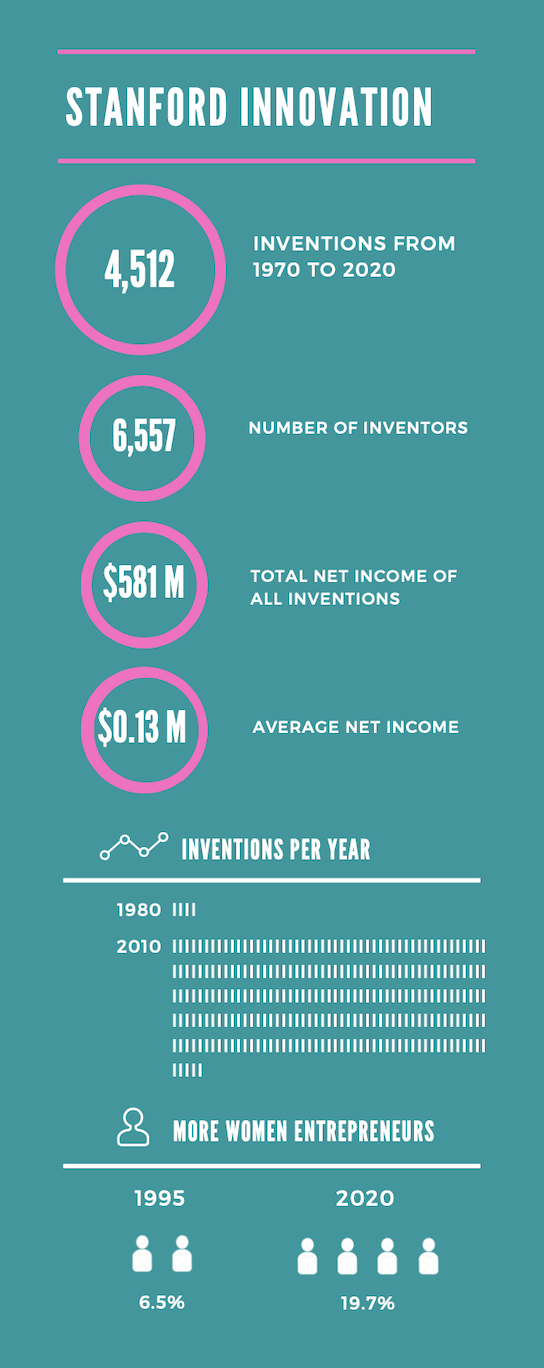Analyzing 50 Years of Stanford Patents

A new study examines the trends in 4,500 Stanford inventions created since 1970.
In January of 1998, the Stanford University Board of Trustees filed a patent for a “Method for Node Ranking in a Linked Database.” The inventor was Lawrence Page, then a PhD student in computer science. A few weeks later, Page and three co-authors, including Sergey Brin, released an academic paper detailing an algorithm that would bring “order to the web,” as they put it.
 If this moment marked Google’s birth, then Stanford’s Office of Technology Licensing (OTL) was the midwife.
If this moment marked Google’s birth, then Stanford’s Office of Technology Licensing (OTL) was the midwife.
The OTL, established in 1970, has helped bring more than 4,500 products invented at Stanford to the commercial market, from early gene-splicing technologies to cancer diagnostics and gyroscopes used in navigation.
“I’ve partnered with OTL quite a bit and gotten really interested in how the innovation and commercialization landscape has changed over the past 50 years,” says James Zou, an assistant professor of biomedical data science at Stanford School of Medicine. Given this interest, he asked OTL if he could review their historical data; they said yes. “This was a really exciting opportunity to do the first systematic study of research translation over the lifetime of the office.”
The results of this study were recently published in Cell Patterns.
At the highest level, Zou and his three Stanford-based co-authors — Weixin Liang, a PhD candidate in the Stanford Department of Computer Science, OTL associate director Scott Elrod, and Daniel McFarland, a professor in the Stanford Graduate School of Education — found that the number of marketed inventions has increased rapidly, from a handful per year in 1980 to 250 per year in 2010, when it plateaued. Among these patents, engineering and electronics-related inventions created the most revenue prior to 2000, while biotech has been the main driver of revenue over the past 20 years. More recently, Zou noted artificial intelligence (AI) starting to show up in OTL revenue, although he sees a lag between research and commercialization.
“But the data we have is much richer than this,” Zou says. “For each one of these thousands of innovations, we have a description provided by the original creators, as well as one by the Office of Technology Licensing, which is used to market new technologies to companies that might be interested.”
Hype vs. Revenue
Curious about the relationship between these descriptions and revenue, Zou’s team created a natural language processing algorithm to look at whether particular linguistic features were more or less predictive of success. It turns out swaggering adjectives like “novel,” “fastest,” or “significant” don’t bode well; these correlate negatively with future revenue.
This result, Zou notes, reveals less about the invention’s marketing than it does about the invention itself. “More successful inventions don’t generally need fluffy adjectives for marketing because they’re the first of something in that space,” he says. “Whereas, if you’re presenting the tenth gadget or algorithm in a given space, it’s a more incremental innovation that relies on being faster or smaller than what came before.”
Shift in Entrepreneur Teams
Finally, the researchers looked at how the composition of teams of inventors has changed over time. Most notably, the number of female team members has tripled over the past 25 years, from 6.5% in 1995 to nearly 20% in 2020. Though this number still falls short of gender parity — 30% of Stanford’s faculty were female in 2020 — it is a trend in the right direction, Zou says.
Teams of inventors have also grown larger and more interdisciplinary. In the 1980s, a single person or a team of two would generally bring a new idea to OTL. In the last decade, these numbers have grown to an average of three or four people from departments across the university; engineers partner with computer scientists and doctors, for instance. “And these are the kinds of teams that have been generating a lot of innovations and revenue,” Zou says.
Though most of this analysis was descriptive, Zou pointed to one clear recommendation for technology licensing offices at any university. The most successful innovations, regardless of sector, were self-licensed. That is, the faculty were encouraged to spin their idea into a startup and then license that technology back to Stanford.
“I think this is an interesting reflection of the entrepreneurial culture at Stanford: If faculty or students have a good idea, they don’t just sell it, but they take it and move forward with it, as with Google,” Zou says. “One takeaway for universities and OTLs, I think, is to develop clear recommendations for how to facilitate self-licensing among faculty.”
Stanford HAI's mission is to advance AI research, education, policy, and practice to improve the human condition. Learn more.
